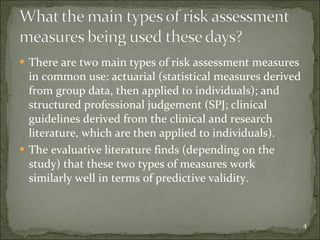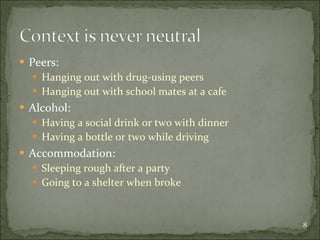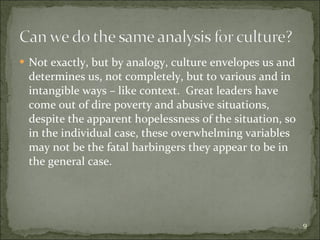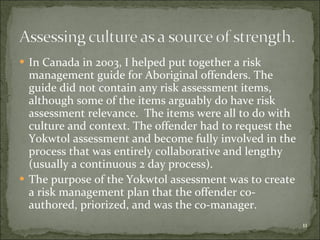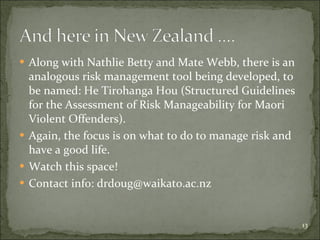He tirohanga hou, Douglas Boer
- 1. Douglas P. Boer, Ph.D., R.Clin.Psych. Associate Professor of Clinical Psychology School of Psychology, University of Waikato July 18, 2010
- 2. What is âForensic Risk Assessmentâ? Risk assessment on non-forensic clients must account for the effect of any possible mental illness on risk Risk assessment on forensic clients must account for the effect of the clients mental illness on their risk What is the difference? Very little, except the issue of responsibility and legal consequence and governing legislation. Essentially, all risk assessments are either forensic in nature (accounting for mental illness) or forensically relevant (can be used with clients who may have mental illness).
- 3. The process of evaluating individuals to: 1. characterize the risk that they will commit violence in the future, and 2. develop interventions to manage or reduce that risk. (Monahan, various dates). What is missing in this definition? The importance of culture and context on the individual. It makes sense that accounting for these variables would increase predictive accuracy in the individual case (idiographic accuracy).
- 4. There are two main types of risk assessment measures in common use: actuarial (statistical measures derived from group data, then applied to individuals); and structured professional judgement (SPJ; clinical guidelines derived from the clinical and research literature, which are then applied to individuals). The evaluative literature finds (depending on the study) that these two types of measures work similarly well in terms of predictive validity.
- 5. Most of the current risk measures are good, to various degrees at: Prediction/classification (actuarials and SPJs) Reflecting change in risk status (SPJs, some actuarials) Providing information for risk reduction intervention planning (SPJs, actuarials are of limited utility in this regard).
- 6. To my knowledge, none of the actuarial measures account for culture or context. Some SPJs can account for culture and context to some degree, but certainly culture is not an explicit variable. In the HCR-2o, for example, the historical item âearly maladjustmentâ accounts for exposure to abuse (being abused or witnessing abuse) as a child. Also, the future risk item âexposure to destabilizersâ item refers to the likelihood of a person being exposed to environmental situations or events that increase that personâs vulnerability to acting violently and increase that potential. Both the SVR-20 and the HCR-20 include ârealistic plansâ as an item and this item is contextualized and individualized, but culture is not included as a consideration in either manual.
- 7. First, letâs not conflate these two concepts or see either as necessary risk-increasing or risk-decreasing. Context is perhaps most obviously risk-relevant. Drugs, antisocial peers, alcohol, jails, poverty, unemployment, gangs, all increase risk. Culture may be risk-relevant if an offender is offending to defend a cultural value (e.g., an honour killing in India) or if a person with legal right to enter a home does so in a culturally-insensitive manner. Of course, it is nonsensical to say that either context or culture is risk neutral.
- 8. Peers: Hanging out with drug-using peers Hanging out with school mates at a cafe Alcohol: Having a social drink or two with dinner Having a bottle or two while driving Accommodation: Sleeping rough after a party Going to a shelter when broke
- 9. Not exactly, but by analogy, culture envelopes us and determines us, not completely, but to various and in intangible ways â like context. Great leaders have come out of dire poverty and abusive situations, despite the apparent hopelessness of the situation, so in the individual case, these overwhelming variables may not be the fatal harbingers they appear to be in the general case.
- 10. Risk management. Can culture and context be more usefully employed as constructs that are evaluated NOT to negatively portray an individual (as is done in a risk assessment, i.e., these are his problems that make him risky). Rather, these constructs can be evaluated positively as well. If we donât want to evaluate culture as a risk-relevant variable, and Iâm of the opinion that doing so is fraught with so many problems that assessing it as anything other than a source of strength is a problem, then we need to look at it as a way out of trouble, a way forward.
- 11. In Canada in 2003, I helped put together a risk management guide for Aboriginal offenders. The guide did not contain any risk assessment items, although some of the items arguably do have risk assessment relevance. The items were all to do with culture and context. The offender had to request the Yokwtol assessment and become fully involved in the process that was entirely collaborative and lengthy (usually a continuous 2 day process). The purpose of the Yokwtol assessment was to create a risk management plan that the offender co-authored, priorized, and was the c0-manager.
- 12. Relationship of offender to heritage Historical/generational issues Foster care history Gains, insights, and behavioural changes Support for victim(s) Support for the offender Lifestyle stability Self-support skills
- 13. Along with Nathlie Betty and Mate Webb, there is an analogous risk management tool being developed, to be named: He Tirohanga Hou (Structured Guidelines for the Assessment of Risk Manageability for Maori Violent Offenders). Again, the focus is on what to do to manage risk and have a good life. Watch this space! Contact info: drdoug@waikato.ac.nz




